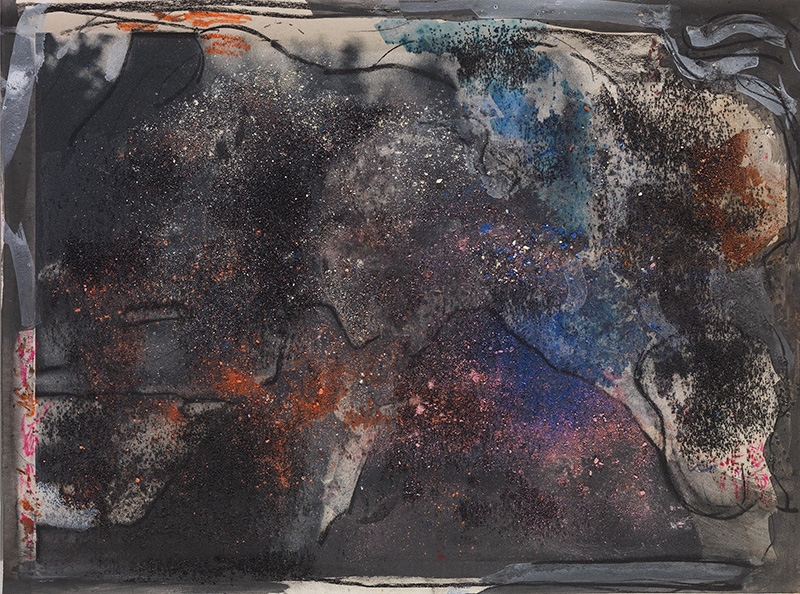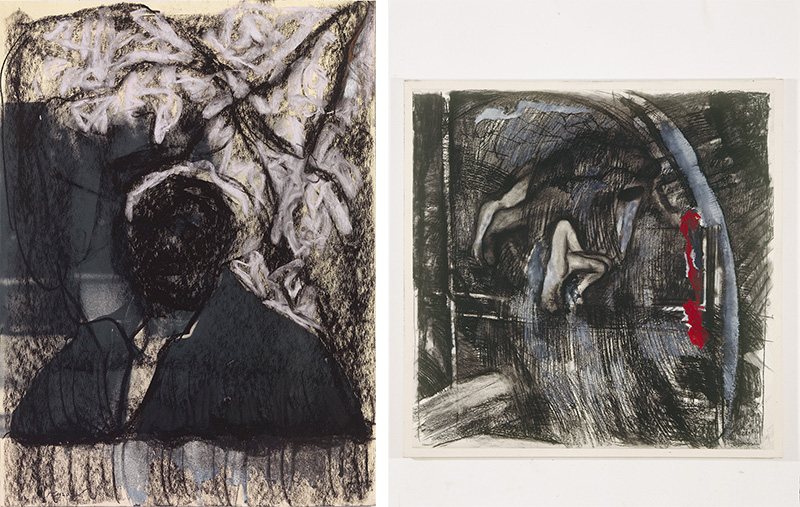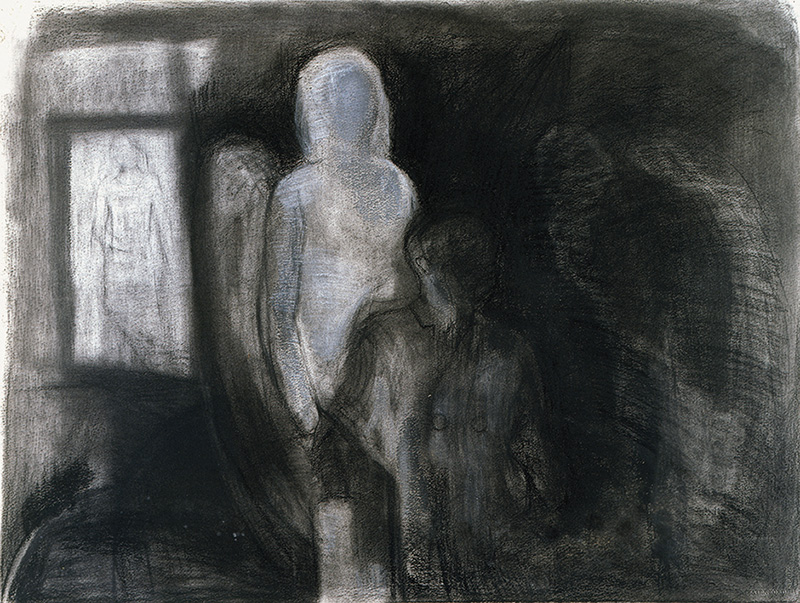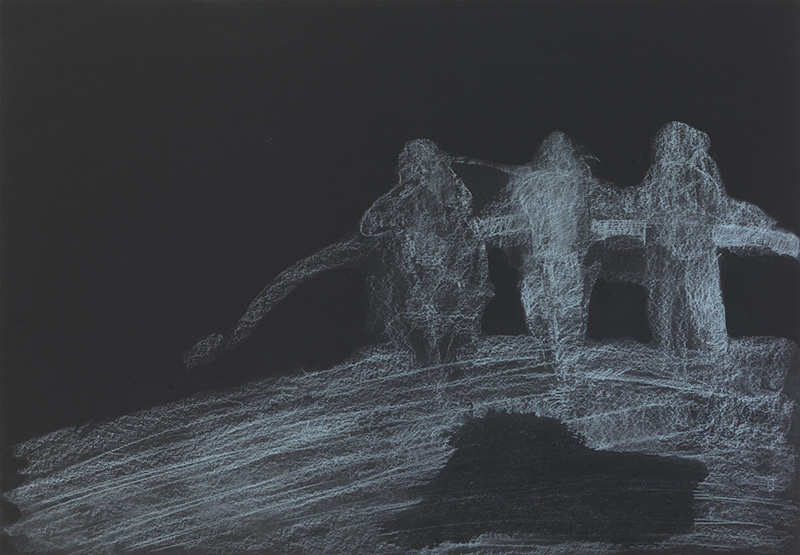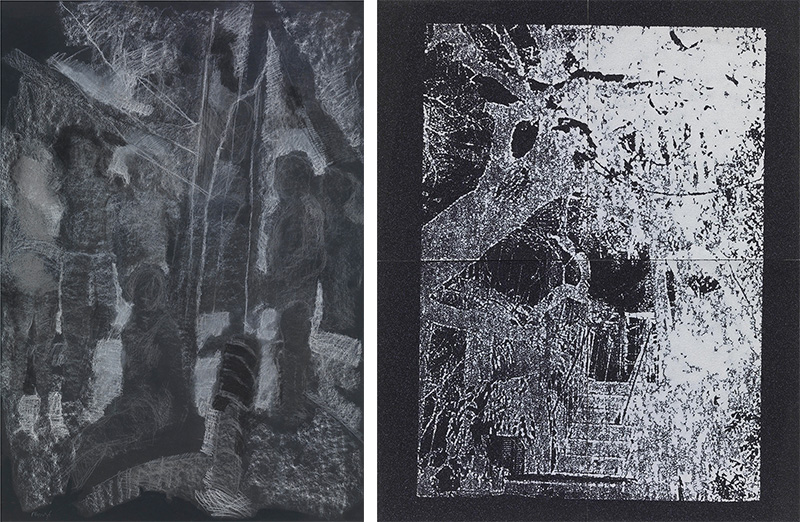INTERVIEW: Pelagia Kyriazi
 Pelagia Kyriazi’s artworks through the logic of the blackboard, are depicted on the black surface of the paper, are traveling us in the past and in the years of our youth, but not with nostalgia and melancholy but with the joy of the human who honors his past and rejoices. Joy is depicted through glitter and light. Basis for her series of artworks and the interview that follows, are the works of Nikolaos Gyzis* that motivated the artist on a new journey and as she says “The phrase by Nikolaos Gyzis* [I throw white on dark colour paper and (what a beautiful discovery) I study (or am taught) and study again], opened a path for me, concerning the austerity of my materials…”.
Pelagia Kyriazi’s artworks through the logic of the blackboard, are depicted on the black surface of the paper, are traveling us in the past and in the years of our youth, but not with nostalgia and melancholy but with the joy of the human who honors his past and rejoices. Joy is depicted through glitter and light. Basis for her series of artworks and the interview that follows, are the works of Nikolaos Gyzis* that motivated the artist on a new journey and as she says “The phrase by Nikolaos Gyzis* [I throw white on dark colour paper and (what a beautiful discovery) I study (or am taught) and study again], opened a path for me, concerning the austerity of my materials…”.
By Efi Michalarou
Photo: Pelagia Kyriazi Archive
Ms. Pelagia Kyriazi your solo exhibition “An Image, an Eidolon” is a narrative in three parts of artworks which, though unrelated at least in terms of theme, on closer look they seem to share some linking elements, like drawing, paper and …?
A drawing is your initial impression. You can intensify it to the point that the initial conception, your inner momentum is conveyed. The core of the exhibition is the drawing in an interplay of negative-positive. I see image as the positive and eidolon as the negative. “Eidolons” emerge from within the black color, while “Images” are the positives and so they need a surrounding space. “Eidolons” inhale-absorb, “Images” exhale-release. Some verses from Walt Whitman’s poem “Eidólons” gave me the connective tissue for the whole exhibition: “Your body permanent/The Body lurking there within thy Body/ The only purport of the Form thou art – the real I myself/An image, an Eidólon”. These verses gave me the dual element. I am an image and at the same time an eidolon of myself, I am a body hidden within my body and the ultimate purpose of the form, is my art.
The first drawings encountered by the viewer in the exhibition are more minimal and then elements and figures are added. Addition-Subtraction-Retraction. What is this process and what does it mean for you?
The process is to capture emotion as raw material. By making a blind start, without a sketch, the artwork is a sketch of itself. The point is the density of the moment, to what extent you want the image exposed. You enter the darkroom of memory, which can bring the image to light with greater precision or may keep it elliptic. Within the darkroom of memory a reality is being created again. The works are abstractions anyway. Since black is your starting point and there is no surrounding space, you are already in a subjective, inner space. The images have been kept at a point where they could theoretically thicken or thin out. The result is more inward, somehow you reverse the process and, instead of working on the image towards the viewer, you let the viewer come closer to your own process. You invite the viewer inside this black, where the conception becomes complete in full intensity.
Although your drawings may seem incomplete, they are complete. What was the triggering event-threshold of this series and, ultimately, the challenge?
Looking at this work in terms of the materials used, we might consider them incomplete because they are created with minimal means but, if we look at them with the concept in mind, then the picture has actually emerged. In an inner way, not intellectual, I let the emotion come out as thickening of the moment. Emotion is in the potential, here is its essence and its strength. Potential is also in the form. The images I made are strong because I gave them this dynamic, to vanish into thin air or come to life before us.
You use black paper and chalk, media that refer to the school blackboard and, actually, some of your works remind of children’s drawings. Was this a conscious process and how did it arise?
“I throw white on dark colour paper and (what a beautiful discovery) I study (or am taught) and study again”. This phrase by Nikolaos Gyzis* opened a path for me, concerning the austerity of my materials. Just black paper and white colour on it can be enough for me. The black and white works have some connection and are a small tribute to my contact with Nikolaos Gyzis. With minimal means you can render the conception of an image.
The images conveyed to us in some of your artworks include the sociability and freedom of childhood, the games in the neighborhood or on some beach. Are you concerned with the fact that over time, innocence, sociability and this sort of clear communication has disappeared in the name of development?
In the black and white drawings, the humans-eidolons are actually in social interaction. They walk on the beach, swim in the sea but, at the same time, what we see is a reality in reverse, the reality of a world in x-ray. In fact, the figure defines the space, there is no security of the surrounding space. The space is black. But is the black void? We can’t be sure. The emerging eidolons are the negatives inside the black. The idea of the eidolon of an image is a more subtle concept. How something appears from nowhere, from chaos. These artworks (the black-and-whites) are the eidolons of an image with all the connotations the word “Eidolon” may have. It may be the eidolon of a dead man for ancient Greeks.
There is an interplay in your work between the photographic negative and the photographic memory, which is imprinted on paper or sandpaper. Is it a game, a gleaming journey in time and memory, just like the glitter that jumps out of the grains of the sandpaper?
The silkscreen prints, created ten years ago, have the sense of grit as a starting point. How there can be a transcription of the material, in other words, the shiny, sandy texture of stone can be perfectly expressed with the use of sandpaper. I was drawn to sandpaper for its density, its surface has no gaps, it is unvarying. What’s more it is ready-made, not something I would have to create myself. Its texture has a shine that transfers the sense of stone on paper. And naturally it encapsulates the sense of time passing by. The emery grain expresses the time that could dissolve or densify the image. The whole story is with the image. It all comes down to the image which also defines the content.
You are also using glitter in your works-homage to the collector. Why did you create these portraits-reference to collectors? What do they mean to you and what is your relationship with them?
The “Collector” could also be the viewer inside me. The second body inside me that views my work. And he poses, as in some of these portraits, somehow divergent, the heads being sideways, in positions that you never expect to see him. Together with the “Collector” comes “The Studio”, a work that again relates to the artist’s inner space, how she experiences her art, her relationship with the collector. The artist’s feelings towards the collector are mixed, they are not always hagiography. In the eyes of the artist he may be falling from the sky or turning upside-down. Talking about form, I was interested in having a paste, a self-made mixture of color. The glitter is metal shavings and pastel shavings that have been rubbed and put down on the paper, on the figure of the collector. I am attacking this surface, I do not stay at a distance. To start with, underneath is a silkscreen with the face of the real collector. And now I come back to it and I want to add a feeling of today. Somehow a visual mish mash. Something like looking at a wall with graffiti, all this variety on the walls of the city, a painted surface that suddenly stops/is cut off and something else begins. We experience time with its interruptions, we do not start something and go straight to the end. Time is interrupted quite a lot, and each interruption brings an overturn of content and, inevitably, a turn in form. In a hidden way the contemporary aesthetics of the city comes out in these works. And glitter is a colour aesthetic that is a bit fake, a little exaggerated, but we like that exaggeration, we like to get high.
* Nikolaos Gyzis is one of the most influential Greek artists of the 19th Century.
First Publication: www.dreamideamachine.com
© Interview-Efi Michalarou
